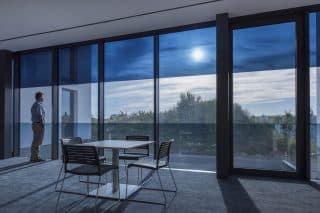The construction trade fair Big5 invited visitors to Dubai in November 2015, not only to take the ultimate ‘selfie’ from a 25-foot-high crane but to partake in several live demonstrations, including 3-D printing concrete displays. Innovations in concrete are trending well beyond the fair.
“Concrete is limited only by someone’s imagination,” Bent Mikkelsen, publisher of Concrete Decor Magazine, told ArchiExpo e-Magazine. “It really has the ability to be stylish and practical at the same time.”
Decorative Concrete: Stained, colored, environmentally friendly
Imagination manifests with colored and patterned concrete. Mixing ground iron oxide particles create black, red, brown and yellow, while cobalt and chromium oxide produce blue and green pigments. Products like Mix-Ready® make adding color easy and create no environmental waste.
Acid-based staining permeates concrete and produces earthy tones like brown and tan. Acid stains bond permanently with concrete, prevent chipping or peeling and help to rejuvenate dull surfaces.
Back in 2009, the San Francisco-based transparent house team created a way to add floral patterns into polished concrete flooring, either during the pouring or after the concrete has set. It’s the same year Tom Ralston Concrete did the J Ellington Library decorative concrete piece. This trend is now starting to flourish.
Both stylish and practical, architect Rudy Ricciotti completed his project on the French museum MuCEM, featuring a lacy concrete cloak that surrounds the building’s exterior, in 2013. And the award-winning John Henry Brookes Building at Oxford Brookes University (Design Engine) uses concrete extensively with precast lattice planks and smooth and textured areas.
Sustainability and Colloidal Nano Silica Technology
“Innovation happens when we have to meet a need or a certain desire,” Alex Rollins, director of the Civil Engineering Materials Research Laboratory at the University of Tennessee at Chattanooga, told ArchiExpo e-Magazine.
Rollins began colloidal nano-silica (CNS) research four years ago and presented his research at the 2015 construction trade fair Big5. He cited a report by the American Society of Civil Engineers stating that one in six bridges in the United States should be replaced; corrosion of reinforcing steel is one of the main causes of shortened bridge life. Water, which carries salts, spreads through the concrete and corrodes the steel.
CNS, used as an admixture or spray-applied, reacts with the bi-products of cement and water causing a chemical reaction known as calcium hydroxide, which helps plug water pathways and reduces concrete shrinkage.
In 2014, Rollins tested CNS on a 70-meter-long quay at the Port of Marseille in France. After a year, the concrete showed no shrinkage or cracks. Learn more about CNS in Rollins’ talk here.
Rollins and co are not alone in this venture; a partnership between the Indiana Department of Transportation (INDOT) and Purdue resulted in the Joint Transportation Research Program. They’re working with Weiss to create internally cured high-performance concrete, said to be used on four bridges in 2013.












